Showing 121–132 of 200 results
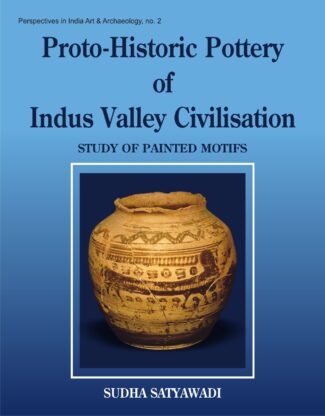
Dr. Satyawadis book is the first-ever study of painted pottery motifs of the Indian subcontinent (earliest times to 1750 BC). It explores the genesis and development of popular forms and classifies art motifs into their different genres.
In the 1920s was found one of the worlds oldest, most mysterious civilizations: the Indus Valley. Which, in view of the relatively more recent archaeological evidence, could possibly have evolved from a much older, indigenous culture: of about nine millennia ago some 6000 years before the growth of Mesopotamian urbanism or about 2000 years before the Egyptians. Among a variety of excavated material remains, pottery affords a significant clue that influences archaeologists conclusions. Despite many a scholars avowed fascination for the pottery of the Indian subcontinent since John Marshalls days, Dr. Satyawadis book becomes the first-ever, exclusive study of its art motifs: from the earliest times to 1750 bc Marshalling a whole diversity of painted-pottery motifs: from potsherds, from excavatory reports, and from as many as twenty archaeological museums of India, it explores the genesis of popular themes/forms and how they developed from their most primitive character to mature Harappan period with sharp focus on their creative purpose, stylistic/formal variants and their spatial-temporal parameters. Also surveying extensively the painted pottery of Indus Valley: of both pre- and post-Harappan cultures, the author painstakingly classifies art motifs into their different genres: religious, ritualistic, decorative, superstitious, and personal. And into their different forms too, like geometrical, floral, faunal, other. In her effort to probe the beginnings of pre-Harappan pottery motifs, the artist in Dr. Satyawadi visualizes their continuity not only in mature Harappan cultures, but even in contemporary folk and tribal art of India: almost in their pristine, primitive form keeping alive, from generation to generation, an insistent, inherently powerful tradition, despite the ravages of time. The author also tries to trace the linkages between the painted motifs (on pottery) of Indus Valley and other old-world cultures, notably, Mesopotamian, Egyptian, Afghan, Iranian, and Baluchi. With one hundred thirty six photographic reproductions, this study is supplemented by over 650 line-drawings which, (all beautifully copied by the author herself straight from museum exhibits), try to capture the panorama of protohistoric art motifs in their essential variety and pristine splendour.

भारतीय पुरातत्त्व परिषद्, नई दिल्ली, के द्वारा प्रकाशित पुरातत्त्व िवज्ञान से सम्बन्धित ‘पुराप्रवाह’ नामक वार्षिक पत्रिका देश में यू॰जी॰सी॰ से मान्यता प्राप्त अकेली हिन्दी की सारगर्भित शोधपत्रिका है जो पुरातत्त्व के विषयाें तथा ऐतिहासिक शोधकार्याें से सम्बन्ध रखती है।
यह वार्षिक पत्रिका विद्वत समीक्षक मण्डल द्वारा अवलोकित होती है तथा इस पत्रिका में प्रकाशित हाेने से पूर्व आलेख काे वरिष्ठ पुरातत्त्ववेत्ताओं एवं उस विषय के विशेषज्ञों को विचारार्थ स्वीकार करने हेतु भेजा जाता है।
इस पत्रिका का प्रकाशन मूलतः राजभाषा व राष्ट्रभाषा हिंदी में पुरातत्त्व के साहित्य को मान्यता देने हेतु एक सार्थक व सशक्त माध्यम है तािक देश की युवा पीढ़ी के पुरातत्त्वज्ञों को अन्वेषणपरक शोध-निबन्धों के लेखन काे िहन्दी में िलखने की प्रेरणा िमल सके। इससे आने वाले समय में पाठकांे के पास पुरातत्त्व सम्बन्धित हिन्दी की सामग्री पर्याप्त रूप से होगी, जो विद्यार्थियों को शोधकार्य करने में अत्यंत सहायक िसद्ध होगी और उन्हें अंग्रेज़ी की पत्रिकाओं एवं पुस्तकों पर निर्भर नहीं रहना पड़ेगा।
‘पुराप्रवाह’ में पुरातत्त्व विज्ञान, इतिहास, अभिलेखिकी, मुद्राशास्त्र, पुरातात्त्विक अन्वेषण, प्रागैतिहासिक युग से सम्बन्धित सामग्री, भारतीय संस्कृति, कला और साहित्य का पुरातत्त्व से अन्यान्योश्रय सामंजस्य जैसे विषयों को समाहित करने का प्रयत्न किया है। इसके अतिरिक्त इस वार्षिक पत्रिका में संग्रहालय-विज्ञान, प्राचीन भारतीय धरोहर, वेद-पुराणों से सम्बद्ध महागाथाओं तथा परम्परागत लोकगाथाओं के लेख भी समािहत करने का प्रावधान रखा गया है।
हमें आशा और विश्वास है कि यह शोध-पत्रिका शीघ्र ही पुरातात्त्विक जगत् में अपनी पहचान बना लेगी।
भारतीय पुरातत्त्व परिषद्, नई दिल्ली, के द्वारा प्रकाशित पुरातत्त्व िवज्ञान से सम्बन्धित ‘पुराप्रवाह’ नामक वार्षिक पत्रिका देश में यू॰जी॰सी॰ से मान्यता प्राप्त अकेली हिन्दी की सारगर्भित शोधपत्रिका है जो पुरातत्त्व के विषयाें तथा ऐतिहासिक शोधकार्याें से सम्बन्ध रखती है।
यह वार्षिक पत्रिका विद्वत समीक्षक मण्डल द्वारा अवलोकित होती है तथा इस पत्रिका में प्रकाशित हाेने से पूर्व आलेख काे वरिष्ठ पुरातत्त्ववेत्ताओं एवं उस विषय के विशेषज्ञों को विचारार्थ स्वीकार करने हेतु भेजा जाता है।
इस पत्रिका का प्रकाशन मूलतः राजभाषा व राष्ट्रभाषा हिंदी में पुरातत्त्व के साहित्य को मान्यता देने हेतु एक सार्थक व सशक्त माध्यम है तािक देश की युवा पीढ़ी के पुरातत्त्वज्ञों को अन्वेषणपरक शोध-निबन्धों के लेखन काे िहन्दी में िलखने की प्रेरणा िमल सके। इससे आने वाले समय में पाठकांे के पास पुरातत्त्व सम्बन्धित हिन्दी की सामग्री पर्याप्त रूप से होगी, जो विद्यार्थियों को शोधकार्य करने में अत्यंत सहायक िसद्ध होगी और उन्हें अंग्रेज़ी की पत्रिकाओं एवं पुस्तकों पर निर्भर नहीं रहना पड़ेगा।
‘पुराप्रवाह’ में पुरातत्त्व विज्ञान, इतिहास, अभिलेखिकी, मुद्राशास्त्र, पुरातात्त्विक अन्वेषण, प्रागैतिहासिक युग से सम्बन्धित सामग्री, भारतीय संस्कृति, कला और साहित्य का पुरातत्त्व से अन्यान्योश्रय सामंजस्य जैसे विषयों को समाहित करने का प्रयत्न किया है। इसके अतिरिक्त इस वार्षिक पत्रिका में संग्रहालय-विज्ञान, प्राचीन भारतीय धरोहर, वेद-पुराणों से सम्बद्ध महागाथाओं तथा परम्परागत लोकगाथाओं के लेख भी समािहत करने का प्रावधान रखा गया है।
हमें आशा और विश्वास है कि यह शोध-पत्रिका शीघ्र ही पुरातात्त्विक जगत् में अपनी पहचान बना लेगी।

भारतीय पुरातत्त्व परिषद्, नई दिल्ली, के द्वारा प्रकाशित पुरातत्त्व िवज्ञान से सम्बन्धित ‘पुराप्रवाह’ नामक वार्षिक पत्रिका देश में यू॰जी॰सी॰ से मान्यता प्राप्त अकेली हिन्दी की सारगर्भित शोधपत्रिका है जो पुरातत्त्व के विषयाें तथा ऐतिहासिक शोधकार्याें से सम्बन्ध रखती है।
यह वार्षिक पत्रिका विद्वत समीक्षक मण्डल द्वारा अवलोकित होती है तथा इस पत्रिका में प्रकाशित हाेने से पूर्व आलेख काे वरिष्ठ पुरातत्त्ववेत्ताओं एवं उस विषय के विशेषज्ञों को विचारार्थ स्वीकार करने हेतु भेजा जाता है।
इस पत्रिका का प्रकाशन मूलतः राजभाषा व राष्ट्रभाषा हिंदी में पुरातत्त्व के साहित्य को मान्यता देने हेतु एक सार्थक व सशक्त माध्यम है तािक देश की युवा पीढ़ी के पुरातत्त्वज्ञों को अन्वेषणपरक शोध-निबन्धों के लेखन काे िहन्दी में िलखने की प्रेरणा िमल सके। इससे आने वाले समय में पाठकांे के पास पुरातत्त्व सम्बन्धित हिन्दी की सामग्री पर्याप्त रूप से होगी, जो विद्यार्थियों को शोधकार्य करने में अत्यंत सहायक िसद्ध होगी और उन्हें अंग्रेज़ी की पत्रिकाओं एवं पुस्तकों पर निर्भर नहीं रहना पड़ेगा।
‘पुराप्रवाह’ में पुरातत्त्व विज्ञान, इतिहास, अभिलेखिकी, मुद्राशास्त्र, पुरातात्त्विक अन्वेषण, प्रागैतिहासिक युग से सम्बन्धित सामग्री, भारतीय संस्कृति, कला और साहित्य का पुरातत्त्व से अन्यान्योश्रय सामंजस्य जैसे विषयों को समाहित करने का प्रयत्न किया है। इसके अतिरिक्त इस वार्षिक पत्रिका में संग्रहालय-विज्ञान, प्राचीन भारतीय धरोहर, वेद-पुराणों से सम्बद्ध महागाथाओं तथा परम्परागत लोकगाथाओं के लेख भी समािहत करने का प्रावधान रखा गया है।
हमें आशा और विश्वास है कि यह शोध-पत्रिका शीघ्र ही पुरातात्त्विक जगत् में अपनी पहचान बना लेगी।
भारतीय पुरातत्त्व परिषद्, नई दिल्ली, के द्वारा प्रकाशित पुरातत्त्व िवज्ञान से सम्बन्धित ‘पुराप्रवाह’ नामक वार्षिक पत्रिका देश में यू॰जी॰सी॰ से मान्यता प्राप्त अकेली हिन्दी की सारगर्भित शोधपत्रिका है जो पुरातत्त्व के विषयाें तथा ऐतिहासिक शोधकार्याें से सम्बन्ध रखती है।
यह वार्षिक पत्रिका विद्वत समीक्षक मण्डल द्वारा अवलोकित होती है तथा इस पत्रिका में प्रकाशित हाेने से पूर्व आलेख काे वरिष्ठ पुरातत्त्ववेत्ताओं एवं उस विषय के विशेषज्ञों को विचारार्थ स्वीकार करने हेतु भेजा जाता है।
इस पत्रिका का प्रकाशन मूलतः राजभाषा व राष्ट्रभाषा हिंदी में पुरातत्त्व के साहित्य को मान्यता देने हेतु एक सार्थक व सशक्त माध्यम है तािक देश की युवा पीढ़ी के पुरातत्त्वज्ञों को अन्वेषणपरक शोध-निबन्धों के लेखन काे िहन्दी में िलखने की प्रेरणा िमल सके। इससे आने वाले समय में पाठकांे के पास पुरातत्त्व सम्बन्धित हिन्दी की सामग्री पर्याप्त रूप से होगी, जो विद्यार्थियों को शोधकार्य करने में अत्यंत सहायक िसद्ध होगी और उन्हें अंग्रेज़ी की पत्रिकाओं एवं पुस्तकों पर निर्भर नहीं रहना पड़ेगा।
‘पुराप्रवाह’ में पुरातत्त्व विज्ञान, इतिहास, अभिलेखिकी, मुद्राशास्त्र, पुरातात्त्विक अन्वेषण, प्रागैतिहासिक युग से सम्बन्धित सामग्री, भारतीय संस्कृति, कला और साहित्य का पुरातत्त्व से अन्यान्योश्रय सामंजस्य जैसे विषयों को समाहित करने का प्रयत्न किया है। इसके अतिरिक्त इस वार्षिक पत्रिका में संग्रहालय-विज्ञान, प्राचीन भारतीय धरोहर, वेद-पुराणों से सम्बद्ध महागाथाओं तथा परम्परागत लोकगाथाओं के लेख भी समािहत करने का प्रावधान रखा गया है।
हमें आशा और विश्वास है कि यह शोध-पत्रिका शीघ्र ही पुरातात्त्विक जगत् में अपनी पहचान बना लेगी।
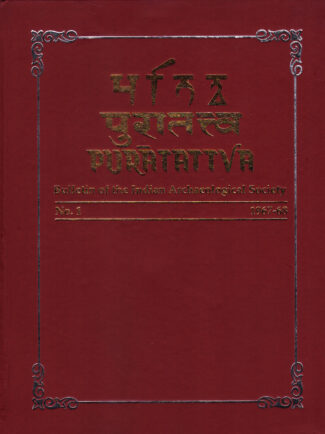
This, an authorised reprint of an annual bulletin of the Indian Archaeological Society, has been offering valuable informations, full with rich insights and innovative viewpoints, on the Indian archaeology that includes excavations, inscriptions, temples, mosques, iconic symbols, paintings, etc. This yearly bulletin is highly recommended for archaeologists, epigraphists, historians and research scholars besides the general readers having interest in such fields.
Puratattva is the annual bulletin of one of the worlds most prestigious academic organization, the Indian Archaeological Society which was founded as early as 1967. From the very beginning, the Society has aimed at publishing the results of the latest archaeological discoveries made in India. Those who have contributed to the journal over the years include not only the eminent archaeologists excavating major sites, like Professors H.D. Sankalia, B.B. Lal, B.P. Sinha, Krishna Deva, A.K. Narain, G.R. Sharma, M.N. Deshpande, B.K. Thapar, S.R. Rao, B.M. Pande, J.P. Joshi, M.C. Joshi, M.S. Nagaraja Rao, A. Sundara, K.N. Dikshit, V.N. Misra, Vibha Tripathi, Rakesh Tiwari, V.S. Wakankar, Giriraj Kishore, K.V. Raman, N.C. Ghosh, K.M. Srivastava, M.A. Dhaky, V.D. Mishra, M.K. Dhavalikar, R.S. Bisht, B.R. Mani, R.C. Agarwal, S.P. Gupta, R.K. Verma, J.N. Pal, U.V. Shinde, Rakesh Tiwari, Alok Tripathi, Amarendra Nath, D.N. Tripathi, Ajith Prasad, K.S. Ramchandran, D.V. Sharma, but also young and budding scholars brimming with new ideas and equipped with new scientific techniques, exploring practically every part of the country and preparing their research works for their Doctoral and post-Doctoral degrees. Scholars from universities and research institutions like the Banaras Hindu University, Madras University, Nagarjuna University, Utkal University, Allahabad University, Patna University, Calcutta University, Mysore University, Baroda University, Kurukshetra University, Rohtak University, Lucknow University, Gorakhpur University, Deccan College, Indian Archaeological Society and the Archaeological Survey of India, the largest body of archeologists in India, to name a few, have been engaged in extensive and intensive field-work in the country. They have been regularly contributing their research-papers to this journal. The subjects covered by these scholars include Stone Age cultures, including Neolithic Culture and the Rock Art, Bronze Age Culture and the Rock Art, Bronze Age Culture of the Harappans found in the Indus and Saraswati basins, Chalcolithinc cultures found in the Deccan, Malwa, Maharashtra, Bengal, Bihar, Madhya Pradesh and Uttar Pradesh, and Early Iron Age cultures, including the Megalithic Culture, throughout India. They also include topics like Underwater Archaeology, Epigraphy, Numismatics, Art, Architecture, Conservation of Monuments, Antiquarian Laws and International Conventions. Puratattva also contains Notes and News, Book Reviews and dialogues between scholars on various issues. So far as many as 34 volumes have been published which provide a mine of information, without referring to which no worthwhile research-work on Indian history and archaeology is at all possible. The articles include even those presented in the Annual Conferences of the Society. This is precisely the reason the Puratattva is consulted throughout the world to gather details on the progress of Indian archaeology and insights on Indian history and culture. It is indeed of permanent value for all scholars and all libraries in India and abroad.

This, an authorised reprint of an annual bulletin of the Indian Archaeological Society, has been offering valuable informations, full with rich insights and innovative viewpoints, on the Indian archaeology that includes excavations, inscriptions, temples, mosques, iconic symbols, paintings, etc. This yearly bulletin is highly recommended for archaeologists, epigraphists, historians and research scholars besides the general readers having interest in such fields.
Puratattva is the annual bulletin of one of the worlds most prestigious academic organization, the Indian Archaeological Society which was founded as early as 1967. From the very beginning, the Society has aimed at publishing the results of the latest archaeological discoveries made in India. Those who have contributed to the journal over the years include not only the eminent archaeologists excavating major sites, like Professors H.D. Sankalia, B.B. Lal, B.P. Sinha, Krishna Deva, A.K. Narain, G.R. Sharma, M.N. Deshpande, B.K. Thapar, S.R. Rao, B.M. Pande, J.P. Joshi, M.C. Joshi, M.S. Nagaraja Rao, A. Sundara, K.N. Dikshit, V.N. Misra, Vibha Tripathi, Rakesh Tiwari, V.S. Wakankar, Giriraj Kishore, K.V. Raman, N.C. Ghosh, K.M. Srivastava, M.A. Dhaky, V.D. Mishra, M.K. Dhavalikar, R.S. Bisht, B.R. Mani, R.C. Agarwal, S.P. Gupta, R.K. Verma, J.N. Pal, U.V. Shinde, Rakesh Tiwari, Alok Tripathi, Amarendra Nath, D.N. Tripathi, Ajith Prasad, K.S. Ramchandran, D.V. Sharma, but also young and budding scholars brimming with new ideas and equipped with new scientific techniques, exploring practically every part of the country and preparing their research works for their Doctoral and post-Doctoral degrees. Scholars from universities and research institutions like the Banaras Hindu University, Madras University, Nagarjuna University, Utkal University, Allahabad University, Patna University, Calcutta University, Mysore University, Baroda University, Kurukshetra University, Rohtak University, Lucknow University, Gorakhpur University, Deccan College, Indian Archaeological Society and the Archaeological Survey of India, the largest body of archeologists in India, to name a few, have been engaged in extensive and intensive field-work in the country. They have been regularly contributing their research-papers to this journal. The subjects covered by these scholars include Stone Age cultures, including Neolithic Culture and the Rock Art, Bronze Age Culture and the Rock Art, Bronze Age Culture of the Harappans found in the Indus and Saraswati basins, Chalcolithinc cultures found in the Deccan, Malwa, Maharashtra, Bengal, Bihar, Madhya Pradesh and Uttar Pradesh, and Early Iron Age cultures, including the Megalithic Culture, throughout India. They also include topics like Underwater Archaeology, Epigraphy, Numismatics, Art, Architecture, Conservation of Monuments, Antiquarian Laws and International Conventions. Puratattva also contains Notes and News, Book Reviews and dialogues between scholars on various issues. So far as many as 34 volumes have been published which provide a mine of information, without referring to which no worthwhile research-work on Indian history and archaeology is at all possible. The articles include even those presented in the Annual Conferences of the Society. This is precisely the reason the Puratattva is consulted throughout the world to gather details on the progress of Indian archaeology and insights on Indian history and culture. It is indeed of permanent value for all scholars and all libraries in India and abroad.
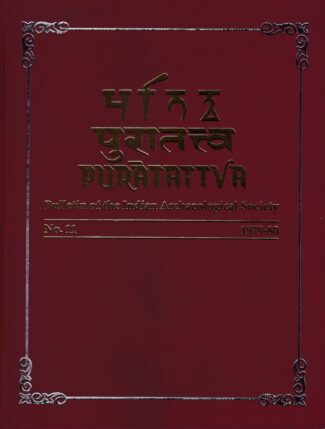
This, an authorised reprint of an annual bulletin of the Indian Archaeological Society, has been offering valuable informations, full with rich insights and innovative viewpoints, on the Indian archaeology that includes excavations, inscriptions, temples, mosques, iconic symbols, paintings, etc. This yearly bulletin is highly recommended for archaeologists, epigraphists, historians and research scholars besides the general readers having interest in such fields.
Puratattva is the annual bulletin of one of the worlds most prestigious academic organization, the Indian Archaeological Society which was founded as early as 1967. From the very beginning, the Society has aimed at publishing the results of the latest archaeological discoveries made in India. Those who have contributed to the journal over the years include not only the eminent archaeologists excavating major sites, like Professors H.D. Sankalia, B.B. Lal, B.P. Sinha, Krishna Deva, A.K. Narain, G.R. Sharma, M.N. Deshpande, B.K. Thapar, S.R. Rao, B.M. Pande, J.P. Joshi, M.C. Joshi, M.S. Nagaraja Rao, A. Sundara, K.N. Dikshit, V.N. Misra, Vibha Tripathi, Rakesh Tiwari, V.S. Wakankar, Giriraj Kishore, K.V. Raman, N.C. Ghosh, K.M. Srivastava, M.A. Dhaky, V.D. Mishra, M.K. Dhavalikar, R.S. Bisht, B.R. Mani, R.C. Agarwal, S.P. Gupta, R.K. Verma, J.N. Pal, U.V. Shinde, Rakesh Tiwari, Alok Tripathi, Amarendra Nath, D.N. Tripathi, Ajith Prasad, K.S. Ramchandran, D.V. Sharma, but also young and budding scholars brimming with new ideas and equipped with new scientific techniques, exploring practically every part of the country and preparing their research works for their Doctoral and post-Doctoral degrees. Scholars from universities and research institutions like the Banaras Hindu University, Madras University, Nagarjuna University, Utkal University, Allahabad University, Patna University, Calcutta University, Mysore University, Baroda University, Kurukshetra University, Rohtak University, Lucknow University, Gorakhpur University, Deccan College, Indian Archaeological Society and the Archaeological Survey of India, the largest body of archeologists in India, to name a few, have been engaged in extensive and intensive field-work in the country. They have been regularly contributing their research-papers to this journal. The subjects covered by these scholars include Stone Age cultures, including Neolithic Culture and the Rock Art, Bronze Age Culture and the Rock Art, Bronze Age Culture of the Harappans found in the Indus and Saraswati basins, Chalcolithinc cultures found in the Deccan, Malwa, Maharashtra, Bengal, Bihar, Madhya Pradesh and Uttar Pradesh, and Early Iron Age cultures, including the Megalithic Culture, throughout India. They also include topics like Underwater Archaeology, Epigraphy, Numismatics, Art, Architecture, Conservation of Monuments, Antiquarian Laws and International Conventions. Puratattva also contains Notes and News, Book Reviews and dialogues between scholars on various issues. So far as many as 34 volumes have been published which provide a mine of information, without referring to which no worthwhile research-work on Indian history and archaeology is at all possible. The articles include even those presented in the Annual Conferences of the Society. This is precisely the reason the Puratattva is consulted throughout the world to gather details on the progress of Indian archaeology and insights on Indian history and culture. It is indeed of permanent value for all scholars and all libraries in India and abroad.
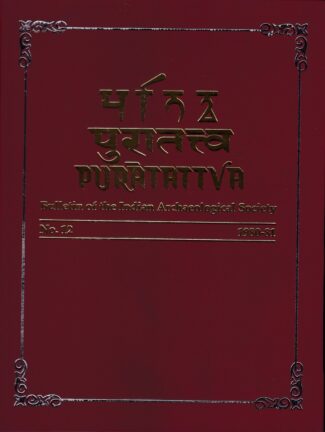
This, an authorised reprint of an annual bulletin of the Indian Archaeological Society, has been offering valuable informations, full with rich insights and innovative viewpoints, on the Indian archaeology that includes excavations, inscriptions, temples, mosques, iconic symbols, paintings, etc. This yearly bulletin is highly recommended for archaeologists, epigraphists, historians and research scholars besides the general readers having interest in such fields.
Puratattva is the annual bulletin of one of the worlds most prestigious academic organization, the Indian Archaeological Society which was founded as early as 1967. From the very beginning, the Society has aimed at publishing the results of the latest archaeological discoveries made in India. Those who have contributed to the journal over the years include not only the eminent archaeologists excavating major sites, like Professors H.D. Sankalia, B.B. Lal, B.P. Sinha, Krishna Deva, A.K. Narain, G.R. Sharma, M.N. Deshpande, B.K. Thapar, S.R. Rao, B.M. Pande, J.P. Joshi, M.C. Joshi, M.S. Nagaraja Rao, A. Sundara, K.N. Dikshit, V.N. Misra, Vibha Tripathi, Rakesh Tiwari, V.S. Wakankar, Giriraj Kishore, K.V. Raman, N.C. Ghosh, K.M. Srivastava, M.A. Dhaky, V.D. Mishra, M.K. Dhavalikar, R.S. Bisht, B.R. Mani, R.C. Agarwal, S.P. Gupta, R.K. Verma, J.N. Pal, U.V. Shinde, Rakesh Tiwari, Alok Tripathi, Amarendra Nath, D.N. Tripathi, Ajith Prasad, K.S. Ramchandran, D.V. Sharma, but also young and budding scholars brimming with new ideas and equipped with new scientific techniques, exploring practically every part of the country and preparing their research works for their Doctoral and post-Doctoral degrees. Scholars from universities and research institutions like the Banaras Hindu University, Madras University, Nagarjuna University, Utkal University, Allahabad University, Patna University, Calcutta University, Mysore University, Baroda University, Kurukshetra University, Rohtak University, Lucknow University, Gorakhpur University, Deccan College, Indian Archaeological Society and the Archaeological Survey of India, the largest body of archeologists in India, to name a few, have been engaged in extensive and intensive field-work in the country. They have been regularly contributing their research-papers to this journal. The subjects covered by these scholars include Stone Age cultures, including Neolithic Culture and the Rock Art, Bronze Age Culture and the Rock Art, Bronze Age Culture of the Harappans found in the Indus and Saraswati basins, Chalcolithinc cultures found in the Deccan, Malwa, Maharashtra, Bengal, Bihar, Madhya Pradesh and Uttar Pradesh, and Early Iron Age cultures, including the Megalithic Culture, throughout India. They also include topics like Underwater Archaeology, Epigraphy, Numismatics, Art, Architecture, Conservation of Monuments, Antiquarian Laws and International Conventions. Puratattva also contains Notes and News, Book Reviews and dialogues between scholars on various issues. So far as many as 34 volumes have been published which provide a mine of information, without referring to which no worthwhile research-work on Indian history and archaeology is at all possible. The articles include even those presented in the Annual Conferences of the Society. This is precisely the reason the Puratattva is consulted throughout the world to gather details on the progress of Indian archaeology and insights on Indian history and culture. It is indeed of permanent value for all scholars and all libraries in India and abroad.
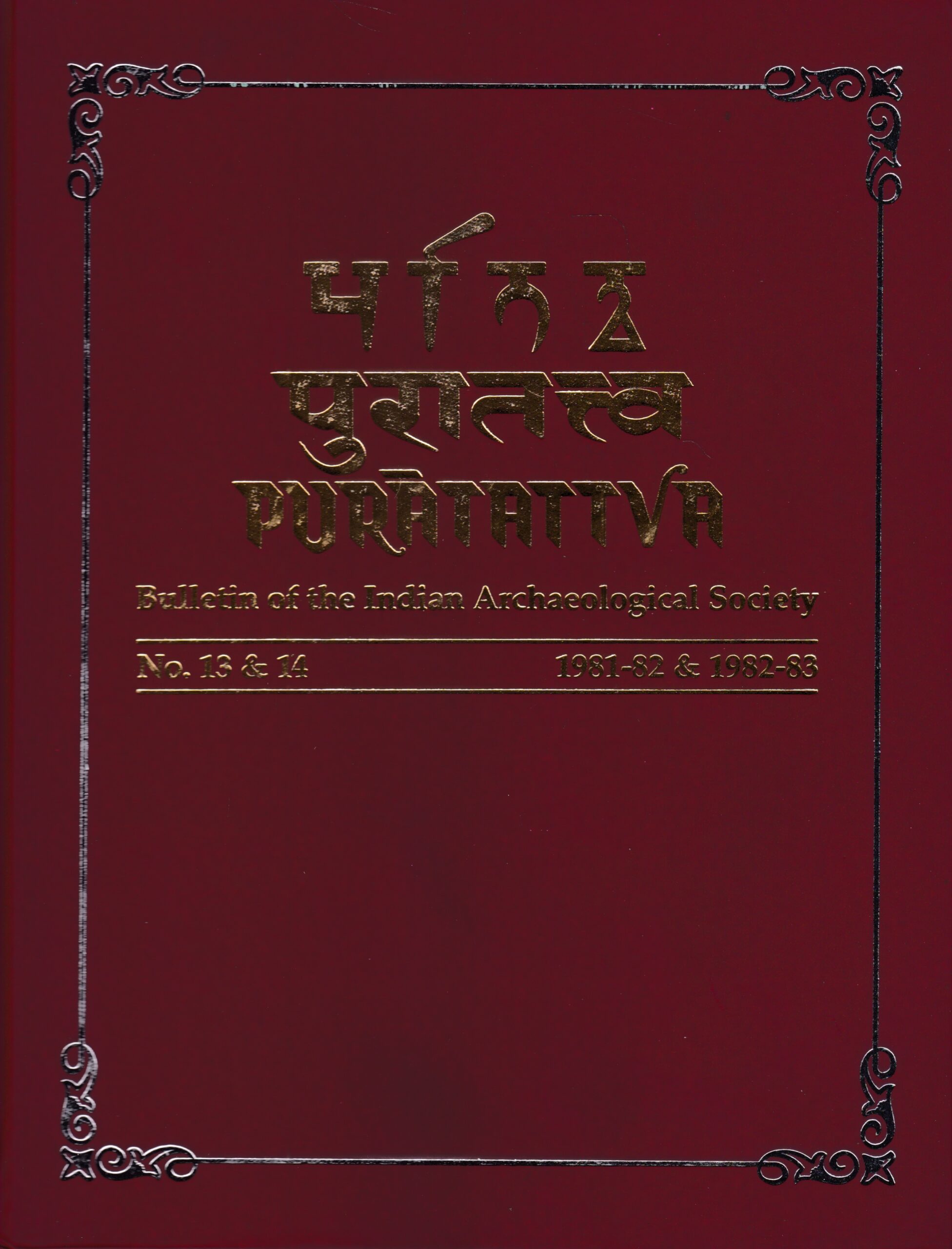
This, an authorised reprint of an annual bulletin of the Indian Archaeological Society, has been offering valuable informations, full with rich insights and innovative viewpoints, on the Indian archaeology that includes excavations, inscriptions, temples, mosques, iconic symbols, paintings, etc. This yearly bulletin is highly recommended for archaeologists, epigraphists, historians and research scholars besides the general readers having interest in such fields.
Puratattva is the annual bulletin of one of the worlds most prestigious academic organization, the Indian Archaeological Society which was founded as early as 1967. From the very beginning, the Society has aimed at publishing the results of the latest archaeological discoveries made in India. Those who have contributed to the journal over the years include not only the eminent archaeologists excavating major sites, like Professors H.D. Sankalia, B.B. Lal, B.P. Sinha, Krishna Deva, A.K. Narain, G.R. Sharma, M.N. Deshpande, B.K. Thapar, S.R. Rao, B.M. Pande, J.P. Joshi, M.C. Joshi, M.S. Nagaraja Rao, A. Sundara, K.N. Dikshit, V.N. Misra, Vibha Tripathi, Rakesh Tiwari, V.S. Wakankar, Giriraj Kishore, K.V. Raman, N.C. Ghosh, K.M. Srivastava, M.A. Dhaky, V.D. Mishra, M.K. Dhavalikar, R.S. Bisht, B.R. Mani, R.C. Agarwal, S.P. Gupta, R.K. Verma, J.N. Pal, U.V. Shinde, Rakesh Tiwari, Alok Tripathi, Amarendra Nath, D.N. Tripathi, Ajith Prasad, K.S. Ramchandran, D.V. Sharma, but also young and budding scholars brimming with new ideas and equipped with new scientific techniques, exploring practically every part of the country and preparing their research works for their Doctoral and post-Doctoral degrees. Scholars from universities and research institutions like the Banaras Hindu University, Madras University, Nagarjuna University, Utkal University, Allahabad University, Patna University, Calcutta University, Mysore University, Baroda University, Kurukshetra University, Rohtak University, Lucknow University, Gorakhpur University, Deccan College, Indian Archaeological Society and the Archaeological Survey of India, the largest body of archeologists in India, to name a few, have been engaged in extensive and intensive field-work in the country. They have been regularly contributing their research-papers to this journal. The subjects covered by these scholars include Stone Age cultures, including Neolithic Culture and the Rock Art, Bronze Age Culture and the Rock Art, Bronze Age Culture of the Harappans found in the Indus and Saraswati basins, Chalcolithinc cultures found in the Deccan, Malwa, Maharashtra, Bengal, Bihar, Madhya Pradesh and Uttar Pradesh, and Early Iron Age cultures, including the Megalithic Culture, throughout India. They also include topics like Underwater Archaeology, Epigraphy, Numismatics, Art, Architecture, Conservation of Monuments, Antiquarian Laws and International Conventions. Puratattva also contains Notes and News, Book Reviews and dialogues between scholars on various issues. So far as many as 34 volumes have been published which provide a mine of information, without referring to which no worthwhile research-work on Indian history and archaeology is at all possible. The articles include even those presented in the Annual Conferences of the Society. This is precisely the reason the Puratattva is consulted throughout the world to gather details on the progress of Indian archaeology and insights on Indian history and culture. It is indeed of permanent value for all scholars and all libraries in India and abroad.
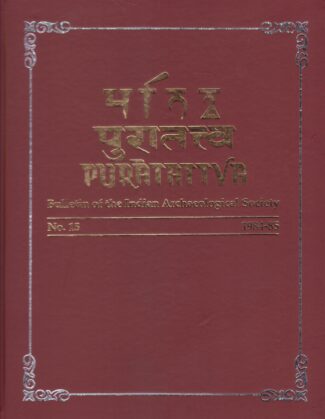
This, an authorised reprint of an annual bulletin of the Indian Archaeological Society, has been offering valuable informations, full with rich insights and innovative viewpoints, on the Indian archaeology that includes excavations, inscriptions, temples, mosques, iconic symbols, paintings, etc. This yearly bulletin is highly recommended for archaeologists, epigraphists, historians and research scholars besides the general readers having interest in such fields.
Puratattva is the annual bulletin of one of the worlds most prestigious academic organization, the Indian Archaeological Society which was founded as early as 1967. From the very beginning, the Society has aimed at publishing the results of the latest archaeological discoveries made in India. Those who have contributed to the journal over the years include not only the eminent archaeologists excavating major sites, like Professors H.D. Sankalia, B.B. Lal, B.P. Sinha, Krishna Deva, A.K. Narain, G.R. Sharma, M.N. Deshpande, B.K. Thapar, S.R. Rao, B.M. Pande, J.P. Joshi, M.C. Joshi, M.S. Nagaraja Rao, A. Sundara, K.N. Dikshit, V.N. Misra, Vibha Tripathi, Rakesh Tiwari, V.S. Wakankar, Giriraj Kishore, K.V. Raman, N.C. Ghosh, K.M. Srivastava, M.A. Dhaky, V.D. Mishra, M.K. Dhavalikar, R.S. Bisht, B.R. Mani, R.C. Agarwal, S.P. Gupta, R.K. Verma, J.N. Pal, U.V. Shinde, Rakesh Tiwari, Alok Tripathi, Amarendra Nath, D.N. Tripathi, Ajith Prasad, K.S. Ramchandran, D.V. Sharma, but also young and budding scholars brimming with new ideas and equipped with new scientific techniques, exploring practically every part of the country and preparing their research works for their Doctoral and post-Doctoral degrees. Scholars from universities and research institutions like the Banaras Hindu University, Madras University, Nagarjuna University, Utkal University, Allahabad University, Patna University, Calcutta University, Mysore University, Baroda University, Kurukshetra University, Rohtak University, Lucknow University, Gorakhpur University, Deccan College, Indian Archaeological Society and the Archaeological Survey of India, the largest body of archeologists in India, to name a few, have been engaged in extensive and intensive field-work in the country. They have been regularly contributing their research-papers to this journal. The subjects covered by these scholars include Stone Age cultures, including Neolithic Culture and the Rock Art, Bronze Age Culture and the Rock Art, Bronze Age Culture of the Harappans found in the Indus and Saraswati basins, Chalcolithinc cultures found in the Deccan, Malwa, Maharashtra, Bengal, Bihar, Madhya Pradesh and Uttar Pradesh, and Early Iron Age cultures, including the Megalithic Culture, throughout India. They also include topics like Underwater Archaeology, Epigraphy, Numismatics, Art, Architecture, Conservation of Monuments, Antiquarian Laws and International Conventions. Puratattva also contains Notes and News, Book Reviews and dialogues between scholars on various issues. So far as many as 34 volumes have been published which provide a mine of information, without referring to which no worthwhile research-work on Indian history and archaeology is at all possible. The articles include even those presented in the Annual Conferences of the Society. This is precisely the reason the Puratattva is consulted throughout the world to gather details on the progress of Indian archaeology and insights on Indian history and culture. It is indeed of permanent value for all scholars and all libraries in India and abroad.
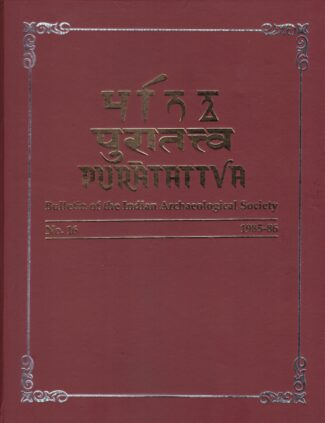
This, an authorised reprint of an annual bulletin of the Indian Archaeological Society, has been offering valuable informations, full with rich insights and innovative viewpoints, on the Indian archaeology that includes excavations, inscriptions, temples, mosques, iconic symbols, paintings, etc. This yearly bulletin is highly recommended for archaeologists, epigraphists, historians and research scholars besides the general readers having interest in such fields.
Puratattva is the annual bulletin of one of the worlds most prestigious academic organization, the Indian Archaeological Society which was founded as early as 1967. From the very beginning, the Society has aimed at publishing the results of the latest archaeological discoveries made in India. Those who have contributed to the journal over the years include not only the eminent archaeologists excavating major sites, like Professors H.D. Sankalia, B.B. Lal, B.P. Sinha, Krishna Deva, A.K. Narain, G.R. Sharma, M.N. Deshpande, B.K. Thapar, S.R. Rao, B.M. Pande, J.P. Joshi, M.C. Joshi, M.S. Nagaraja Rao, A. Sundara, K.N. Dikshit, V.N. Misra, Vibha Tripathi, Rakesh Tiwari, V.S. Wakankar, Giriraj Kishore, K.V. Raman, N.C. Ghosh, K.M. Srivastava, M.A. Dhaky, V.D. Mishra, M.K. Dhavalikar, R.S. Bisht, B.R. Mani, R.C. Agarwal, S.P. Gupta, R.K. Verma, J.N. Pal, U.V. Shinde, Rakesh Tiwari, Alok Tripathi, Amarendra Nath, D.N. Tripathi, Ajith Prasad, K.S. Ramchandran, D.V. Sharma, but also young and budding scholars brimming with new ideas and equipped with new scientific techniques, exploring practically every part of the country and preparing their research works for their Doctoral and post-Doctoral degrees. Scholars from universities and research institutions like the Banaras Hindu University, Madras University, Nagarjuna University, Utkal University, Allahabad University, Patna University, Calcutta University, Mysore University, Baroda University, Kurukshetra University, Rohtak University, Lucknow University, Gorakhpur University, Deccan College, Indian Archaeological Society and the Archaeological Survey of India, the largest body of archeologists in India, to name a few, have been engaged in extensive and intensive field-work in the country. They have been regularly contributing their research-papers to this journal. The subjects covered by these scholars include Stone Age cultures, including Neolithic Culture and the Rock Art, Bronze Age Culture and the Rock Art, Bronze Age Culture of the Harappans found in the Indus and Saraswati basins, Chalcolithinc cultures found in the Deccan, Malwa, Maharashtra, Bengal, Bihar, Madhya Pradesh and Uttar Pradesh, and Early Iron Age cultures, including the Megalithic Culture, throughout India. They also include topics like Underwater Archaeology, Epigraphy, Numismatics, Art, Architecture, Conservation of Monuments, Antiquarian Laws and International Conventions. Puratattva also contains Notes and News, Book Reviews and dialogues between scholars on various issues. So far as many as 34 volumes have been published which provide a mine of information, without referring to which no worthwhile research-work on Indian history and archaeology is at all possible. The articles include even those presented in the Annual Conferences of the Society. This is precisely the reason the Puratattva is consulted throughout the world to gather details on the progress of Indian archaeology and insights on Indian history and culture. It is indeed of permanent value for all scholars and all libraries in India and abroad.
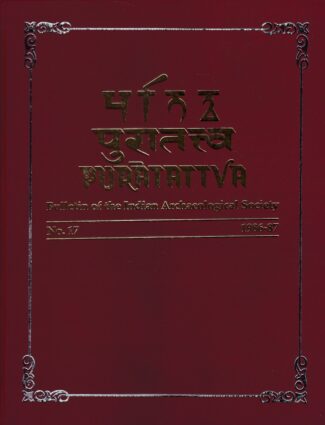
This, an authorised reprint of an annual bulletin of the Indian Archaeological Society, has been offering valuable informations, full with rich insights and innovative viewpoints, on the Indian archaeology that includes excavations, inscriptions, temples, mosques, iconic symbols, paintings, etc. This yearly bulletin is highly recommended for archaeologists, epigraphists, historians and research scholars besides the general readers having interest in such fields.
Puratattva is the annual bulletin of one of the worlds most prestigious academic organization, the Indian Archaeological Society which was founded as early as 1967. From the very beginning, the Society has aimed at publishing the results of the latest archaeological discoveries made in India. Those who have contributed to the journal over the years include not only the eminent archaeologists excavating major sites, like Professors H.D. Sankalia, B.B. Lal, B.P. Sinha, Krishna Deva, A.K. Narain, G.R. Sharma, M.N. Deshpande, B.K. Thapar, S.R. Rao, B.M. Pande, J.P. Joshi, M.C. Joshi, M.S. Nagaraja Rao, A. Sundara, K.N. Dikshit, V.N. Misra, Vibha Tripathi, Rakesh Tiwari, V.S. Wakankar, Giriraj Kishore, K.V. Raman, N.C. Ghosh, K.M. Srivastava, M.A. Dhaky, V.D. Mishra, M.K. Dhavalikar, R.S. Bisht, B.R. Mani, R.C. Agarwal, S.P. Gupta, R.K. Verma, J.N. Pal, U.V. Shinde, Rakesh Tiwari, Alok Tripathi, Amarendra Nath, D.N. Tripathi, Ajith Prasad, K.S. Ramchandran, D.V. Sharma, but also young and budding scholars brimming with new ideas and equipped with new scientific techniques, exploring practically every part of the country and preparing their research works for their Doctoral and post-Doctoral degrees. Scholars from universities and research institutions like the Banaras Hindu University, Madras University, Nagarjuna University, Utkal University, Allahabad University, Patna University, Calcutta University, Mysore University, Baroda University, Kurukshetra University, Rohtak University, Lucknow University, Gorakhpur University, Deccan College, Indian Archaeological Society and the Archaeological Survey of India, the largest body of archeologists in India, to name a few, have been engaged in extensive and intensive field-work in the country. They have been regularly contributing their research-papers to this journal. The subjects covered by these scholars include Stone Age cultures, including Neolithic Culture and the Rock Art, Bronze Age Culture and the Rock Art, Bronze Age Culture of the Harappans found in the Indus and Saraswati basins, Chalcolithinc cultures found in the Deccan, Malwa, Maharashtra, Bengal, Bihar, Madhya Pradesh and Uttar Pradesh, and Early Iron Age cultures, including the Megalithic Culture, throughout India. They also include topics like Underwater Archaeology, Epigraphy, Numismatics, Art, Architecture, Conservation of Monuments, Antiquarian Laws and International Conventions. Puratattva also contains Notes and News, Book Reviews and dialogues between scholars on various issues. So far as many as 34 volumes have been published which provide a mine of information, without referring to which no worthwhile research-work on Indian history and archaeology is at all possible. The articles include even those presented in the Annual Conferences of the Society. This is precisely the reason the Puratattva is consulted throughout the world to gather details on the progress of Indian archaeology and insights on Indian history and culture. It is indeed of permanent value for all scholars and all libraries in India and abroad.
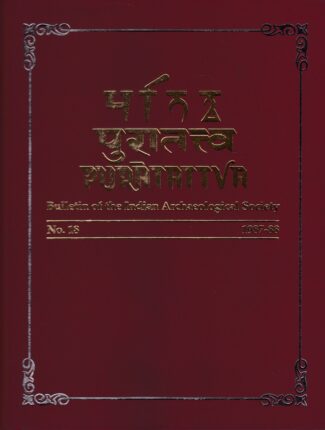
This, an authorised reprint of an annual bulletin of the Indian Archaeological Society, has been offering valuable informations, full with rich insights and innovative viewpoints, on the Indian archaeology that includes excavations, inscriptions, temples, mosques, iconic symbols, paintings, etc. This yearly bulletin is highly recommended for archaeologists, epigraphists, historians and research scholars besides the general readers having interest in such fields.
Puratattva is the annual bulletin of one of the worlds most prestigious academic organization, the Indian Archaeological Society which was founded as early as 1967. From the very beginning, the Society has aimed at publishing the results of the latest archaeological discoveries made in India. Those who have contributed to the journal over the years include not only the eminent archaeologists excavating major sites, like Professors H.D. Sankalia, B.B. Lal, B.P. Sinha, Krishna Deva, A.K. Narain, G.R. Sharma, M.N. Deshpande, B.K. Thapar, S.R. Rao, B.M. Pande, J.P. Joshi, M.C. Joshi, M.S. Nagaraja Rao, A. Sundara, K.N. Dikshit, V.N. Misra, Vibha Tripathi, Rakesh Tiwari, V.S. Wakankar, Giriraj Kishore, K.V. Raman, N.C. Ghosh, K.M. Srivastava, M.A. Dhaky, V.D. Mishra, M.K. Dhavalikar, R.S. Bisht, B.R. Mani, R.C. Agarwal, S.P. Gupta, R.K. Verma, J.N. Pal, U.V. Shinde, Rakesh Tiwari, Alok Tripathi, Amarendra Nath, D.N. Tripathi, Ajith Prasad, K.S. Ramchandran, D.V. Sharma, but also young and budding scholars brimming with new ideas and equipped with new scientific techniques, exploring practically every part of the country and preparing their research works for their Doctoral and post-Doctoral degrees. Scholars from universities and research institutions like the Banaras Hindu University, Madras University, Nagarjuna University, Utkal University, Allahabad University, Patna University, Calcutta University, Mysore University, Baroda University, Kurukshetra University, Rohtak University, Lucknow University, Gorakhpur University, Deccan College, Indian Archaeological Society and the Archaeological Survey of India, the largest body of archeologists in India, to name a few, have been engaged in extensive and intensive field-work in the country. They have been regularly contributing their research-papers to this journal. The subjects covered by these scholars include Stone Age cultures, including Neolithic Culture and the Rock Art, Bronze Age Culture and the Rock Art, Bronze Age Culture of the Harappans found in the Indus and Saraswati basins, Chalcolithinc cultures found in the Deccan, Malwa, Maharashtra, Bengal, Bihar, Madhya Pradesh and Uttar Pradesh, and Early Iron Age cultures, including the Megalithic Culture, throughout India. They also include topics like Underwater Archaeology, Epigraphy, Numismatics, Art, Architecture, Conservation of Monuments, Antiquarian Laws and International Conventions. Puratattva also contains Notes and News, Book Reviews and dialogues between scholars on various issues. So far as many as 34 volumes have been published which provide a mine of information, without referring to which no worthwhile research-work on Indian history and archaeology is at all possible. The articles include even those presented in the Annual Conferences of the Society. This is precisely the reason the Puratattva is consulted throughout the world to gather details on the progress of Indian archaeology and insights on Indian history and culture. It is indeed of permanent value for all scholars and all libraries in India and abroad.
| There are no products |